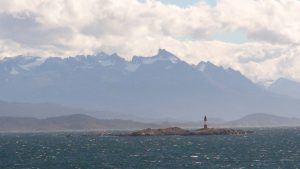54d 55m 55.1s S, 67d 08m 29.2s W (WP081)
Sailing due East out through the Beagle Channel, our journey to the South Atlantic Ocean and the Antarctic Ocean began. A local pilot, based in Ushuaia, steers the boats that depart from or return to Ushuaia, so the first five hours of our trip were at the helm of such a man. The Polar Pioneer traveled an average of 12 knots during this leg. The goings were calm, the scenery was magnificent with Argentina to our North & East and Chile to our South & West, and Magellanic Penguins could be seen swimming in the strait with Cormorants flying in low formation.








